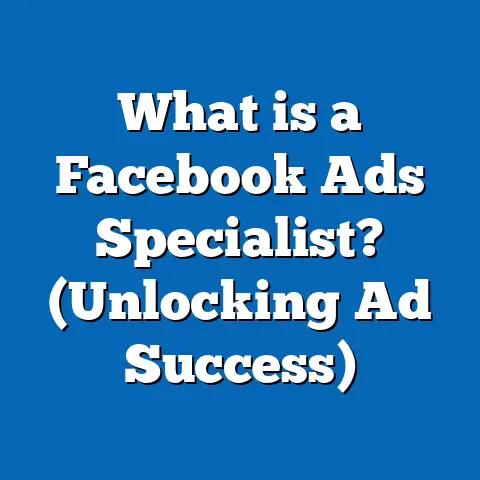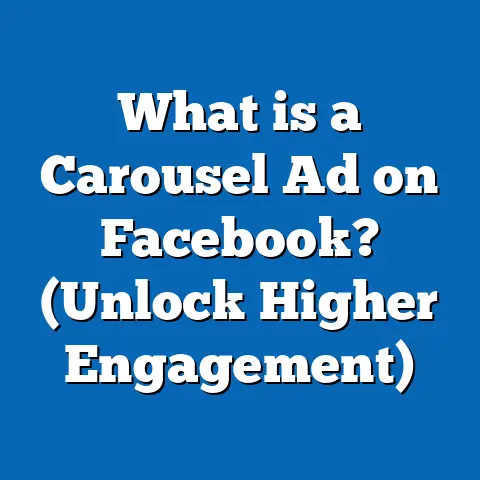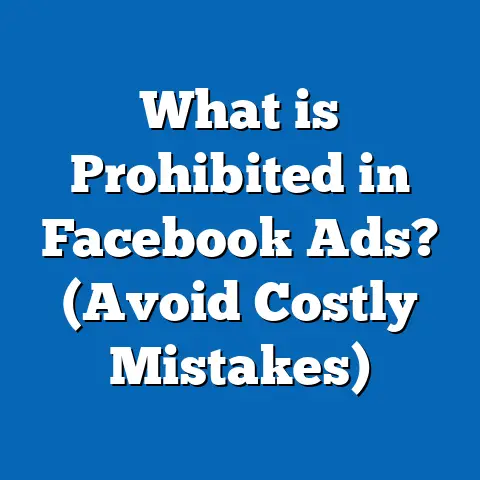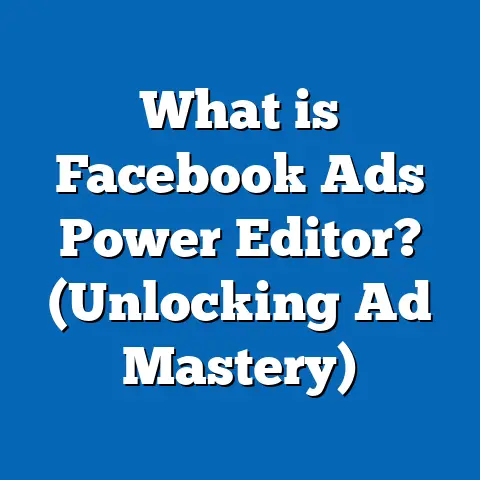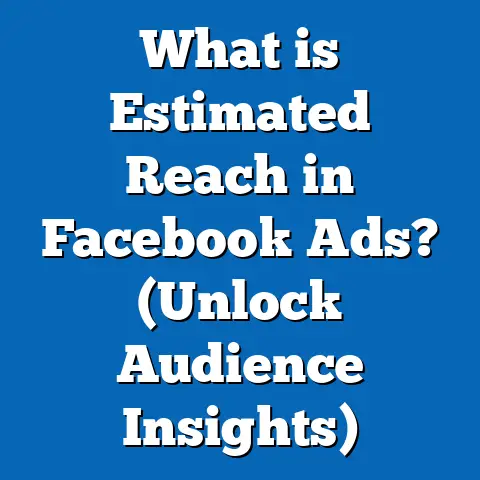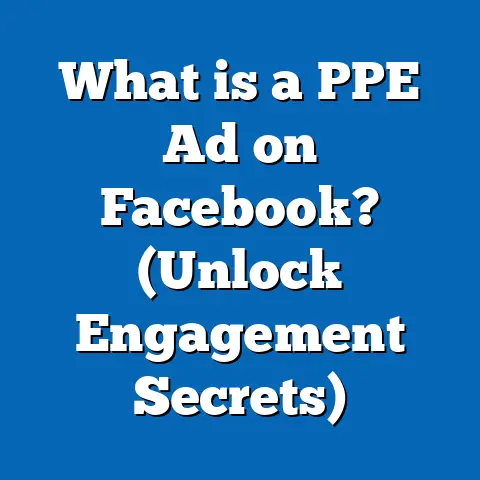What is a Facebook Display Ad? (Unlocking Engagement Secrets)
What is a Facebook Display Ad? (Unlocking Engagement Secrets)
Introduction: The Rise of Visual Advertising in the Digital Age
Digital advertising is evolving at an unprecedented pace. As attention spans shrink and competition intensifies, visual content has emerged as a crucial factor in capturing and maintaining consumer interest. Among the platforms leading this charge is Facebook—now part of Meta—with an ecosystem that spans Facebook itself, Instagram, Messenger, and the Audience Network. According to Meta’s Q1 2025 report, Facebook alone boasts nearly 3 billion monthly active users worldwide, making it an advertising powerhouse.
Over the past decade, advertisers have shifted away from text-heavy ads toward visually rich formats to cut through the noise. Display ads on Facebook have gone from simple banner-like images to dynamic, interactive placements that blend seamlessly into users’ feeds and stories. This transformation reflects broader consumer behavior trends favoring video and imagery over words.
Understanding Facebook Display Ads
What Are Facebook Display Ads?
A Facebook display ad is a paid advertisement consisting primarily of visual content—images or videos—combined with concise copy and call-to-action buttons. These ads appear in various placements within Facebook’s ecosystem:
- News Feed (desktop and mobile)
- Stories
- Right Column (desktop)
- Marketplace
- Instagram Feed & Stories
- Messenger Inbox and Stories
- Audience Network (third-party apps and websites)
The defining feature of display ads is their reliance on visuals to grab attention quickly as users scroll through their feeds or browse apps. Unlike text-only ads or boosted posts with minimal visuals, display ads are designed to stand out with compelling imagery or motion.
Why the Focus on Visuals?
Research consistently shows that humans process images 60,000 times faster than text. Visual content triggers emotional responses quicker and more deeply than words alone. Facebook display ads tap into this by combining compelling visuals with targeted messaging to influence consumer behavior.
The Evolution of Facebook Display Ads: From Static Banners to Dynamic Experiences
Early Days: Simple Image Ads
Initially, Facebook ads were mostly static images with brief text overlays. These were effective for basic brand awareness but limited in engagement potential.
Introduction of Video and Carousel Ads
Recognizing the power of storytelling, Facebook introduced video ads and carousel formats. Video ads allow brands to demonstrate products or tell richer stories in 15-30 seconds. Carousel ads enable showcasing multiple products or features within one ad unit.
Interactive Formats: Collection and Instant Experience Ads
To deepen engagement, Facebook launched Collection Ads—immersive experiences combining video/images with product catalogs—and Instant Experience (formerly Canvas) ads that load full-screen experiences instantly on mobile.
AI-Powered Optimization
Today, Facebook’s AI-driven Dynamic Creative Optimization automatically tests ad variations to find what resonates best with different audience segments, optimizing engagement in real-time without manual interference.
Data-Backed Insights: Why Facebook Display Ads Work
Market Penetration
- 2.96 billion monthly active users globally (Meta Q1 2025).
- Average user spends 38 minutes daily on Facebook ecosystem apps.
- Over 70% of users log in daily, providing consistent ad impressions.
Engagement Metrics
- Visual posts receive more than twice the engagement compared to text-only posts.
- HubSpot 2024 data shows Facebook display ads have an average CTR of 1.11%, higher than industry averages for display ads.
- Mobile-first video ads see a 40% increase in engagement year-over-year due to smartphone dominance.
Conversion and ROI
- WordStream reports that well-targeted Facebook display campaigns deliver an average ROAS of 4:1.
- Compared to Google Display Network, Facebook display ads have a 30% higher conversion rate in similar budget ranges.
- E-commerce businesses frequently report 150-200% increases in sales when incorporating carousel or collection ads into their campaigns.
Anatomy of a Successful Facebook Display Ad
Creating a high-performing Facebook display ad involves several key components:
Visual Elements
- Quality Imagery: Crisp, professional-quality images or videos aligned with brand aesthetics.
- Focus: Clear focal points such as the product or key message.
- Color Psychology: Using colors strategically to evoke emotions (e.g., red for urgency, blue for trust).
- Mobile Optimization: Since 98%+ of users access via mobile devices, visuals must render well on small screens without losing impact.
- Brand Consistency: Maintain logos, fonts, and color palettes consistent with overall brand identity.
Copywriting
- Headlines: Short but impactful; ideally under 40 characters.
- Body Text: Benefits-driven language focusing on what the user gains.
- Call-to-Action (CTA): Clear instructions like “Buy Now,” “Download,” or “Sign Up” that encourage immediate action.
- Emotional Triggers: Words that evoke curiosity, urgency, or exclusivity can boost clicks.
Technical Specifications
Facebook recommends:
| Format | Recommended Size | Text Limits | Other Notes |
|---|---|---|---|
| Single Image | 1200 x 628 pixels | Headline: 40 characters | Keep image file <30MB |
| Video | Minimum 1080 x 1080 pixels | Caption: 125 characters | Max length 240 minutes |
| Carousel | 1080 x 1080 pixels | Up to 10 cards per ad | Each card can have individual links |
| Collection | Varies | Combines video/image + product catalog | Mobile only |
Optimizing these specs ensures your ads look professional and load quickly.
Types of Facebook Display Ads Explained
Single Image Ads
The simplest format featuring one image with text and a CTA button. Best for:
- Highlighting a single product or service
- Brand awareness campaigns
- Driving quick actions like app installs or event signups
Carousel Ads
Multiple swipeable cards—each with its own image/video, headline, description, and link. Ideal for:
- E-commerce brands showcasing product ranges
- Storytelling across sequential cards
- Highlighting different features of one product
Studies show carousel ads can increase CTR by up to 72% compared to single image ads.
Video Ads
Videos capture attention more effectively than still images. Use cases include:
- Demonstrations or tutorials
- Customer testimonials
- Brand storytelling
Videos under 30 seconds have the highest completion rates. Adding captions boosts engagement by 12% as many watch without sound.
Collection Ads
These combine a cover video/image with product catalogs underneath, allowing users to browse products within the ad without leaving Facebook. They are especially effective for mobile e-commerce.
Slideshow Ads
Slideshows are lightweight video-like ads created from still images with motion effects. Perfect for advertisers targeting regions with slow internet speeds.
Unlocking Advanced Targeting Capabilities
Facebook’s strength lies in its unparalleled targeting options:
Core Audiences
Based on user demographics like age, gender, location, language.
Custom Audiences
Upload your customer lists or retarget website visitors to reconnect with warm leads.
Lookalike Audiences
Find users similar to your best customers based on behaviors and interests.
Detailed Interest Targeting
Includes hobbies, favorite brands, activities, purchase behaviors.
Behavior Based Targeting
Target based on device usage, travel habits, purchase history.
Precision targeting boosts relevance scores, leading to lower costs per click and higher engagement rates.
Dynamic Creative Optimization (DCO): The AI Behind Engagement
Facebook’s DCO automatically generates multiple ad combinations by mixing headlines, images/videos, descriptions, and CTAs. It then serves the best-performing combos based on real-time data feedback.
Benefits include:
- Efficient testing without manual setup
- Continuous improvement in ad relevance
- Better resource allocation for marketers
Marketers leveraging DCO report up to 30% improvement in CTR within weeks.
Deep Dive: How to Craft High-Converting Visuals for Display Ads
Step 1: Understand Your Audience Visually
Use audience insights from Facebook Analytics to identify visual preferences—colors, styles, themes that resonate.
Step 2: Use Tools for Design Consistency
Leverage tools like Canva or Adobe Spark optimized for social media dimensions. Use templates aligned with brand guidelines.
Step 3: Incorporate Human Faces
Ads with human faces get up to 38% more engagement due to emotional connection triggers.
Step 4: Test Different Formats and Lengths
For video ads:
- Test short (15 sec) versus longer (30 sec)
- Use captions for silent viewing
- Include brand logo early (within first 3 seconds)
For images:
- Test lifestyle photos versus product-only shots
- Use contrasting colors for CTAs
Case Studies: Real Businesses Unlocking Engagement Secrets
Case Study 1: Fashion Brand Scales Sales by 150% via Carousel Ads
A mid-sized fashion retailer targeted lookalike audiences created from their best customers using carousel ads showcasing new arrivals. They rotated creatives weekly to combat ad fatigue.
Results:
- Sales increased by 150% within three months
- CTR improved from 0.8% to 1.9%
- Cost per acquisition (CPA) dropped by 25%
Key Insight: The carousel format allowed storytelling through multiple products while precise targeting ensured relevance.
Case Study 2: SaaS Company Doubles Lead Generation Using Video Ads
A B2B software provider created short explainer videos targeting small business owners through video ads optimized with captions.
Results:
- Leads increased by 200% over six weeks
- Cost per lead dropped by 35%
- Engagement rate improved by 45%
Key Insight: Video storytelling clarified complex product benefits quickly and effectively.
Case Study 3: Local Restaurant Drives Foot Traffic Using Story Ads
A restaurant used Facebook Stories ads featuring behind-the-scenes videos combined with special offers targeted at local audiences within a 10-mile radius.
Results:
- Foot traffic increased by 20% during campaign periods
- Story completion rate reached 70%
- Coupon redemption rate was 15%
Key Insight: Localized story ads create immediacy and authenticity that drive offline actions.
Comparing Facebook Display Ads with Other Platforms
| Feature | Facebook Display Ads | Google Display Network | Instagram Ads | TikTok Ads |
|---|---|---|---|---|
| User Base | Nearly 3 billion monthly active users | Billions across websites | Over 2 billion | Over 1 billion |
| Targeting Precision | Highly granular based on deep user data | Contextual + demographic | Similar to Facebook (Meta-owned) | Interest & behavioral targeting |
| Ad Formats | Image, video, carousel, collection | Image, video, responsive | Image, video, stories | Short video-focused |
| Engagement Rate | Average CTR ~1.11% | Average CTR ~0.46% | Usually higher than Facebook | High engagement but younger demo |
| Mobile Optimization | Strong | Varies | Very strong | Very strong |
| Cost | Average CPC $0.97 | Average CPC $1.19 | Similar or slightly higher | Varies widely |
| AI Optimization | Dynamic Creative Optimization built-in | Limited AI optimization | Similar to Facebook | Emerging AI features |
Facebook’s integration across apps gives it an edge in unified audience data for personalized advertising.
Advanced Strategies to Maximize Engagement on Facebook Display Ads
Retargeting Campaigns
Retarget users who engaged but didn’t convert with personalized offers or reminders. Dynamic Product Ads (DPAs) show users products they viewed but didn’t buy.
User Generated Content (UGC)
Incorporate authentic customer photos or testimonials into display ads to build trust — UGC increases click-through rates by up to 28%.
A/B Testing Frameworks
Test different variables methodically:
- Visuals (images vs videos)
- Headlines (benefit-driven vs curiosity)
- CTA wording
- Audience segments
Use Facebook Split Testing tools for reliable results.
Seasonal & Trend-Based Themes
Align campaigns with holidays (Black Friday), events (World Cup), or trending topics relevant to your audience’s interests.
Common Challenges & How To Overcome Them
| Challenge | Cause | Solution |
|---|---|---|
| Ad Fatigue | Same creative over time | Rotate creatives frequently |
| Low Click Through Rate (CTR) | Poor targeting or unclear CTA | Refine audience segments; improve CTA clarity |
| High Cost Per Click (CPC) | Competitive industries | Optimize bidding; test budget allocations |
| Mobile Experience Issues | Non-responsive design | Design mobile-first visuals |
| Policy Violations | Non-compliance with ad guidelines | Regularly review Facebook policies |
The Future of Facebook Display Advertising
Facebook continues pushing innovations such as:
- Augmented Reality (AR) Ads: Interactive AR experiences that let users try products virtually.
- Conversational Ads: Integrating Messenger bots within ads for instant customer interaction.
- AI-Powered Predictive Analytics: Advanced insights anticipating user behaviors before campaign launch.
- Enhanced Attribution Models: Better tracking across devices and channels improving ROI measurement.
Staying current allows marketers to leverage emerging tools ahead of competition.
Summary and Next Steps for Marketers and Business Owners
Facebook display ads are critical tools combining powerful visuals with advanced targeting capabilities that drive high engagement and conversion rates. Key points include:
- Visual content drives significantly more engagement than text alone.
- Multiple ad formats offer flexibility from simple images to immersive collections.
- Precision targeting ensures relevance and cost efficiency.
- AI-powered tools like Dynamic Creative Optimization improve performance automatically.
- Rigorous testing and creative rotation prevent ad fatigue.
Next steps:
- Audit your current Facebook ad strategy focusing on visual content quality.
- Experiment with carousel and video ads for storytelling.
- Leverage retargeting combined with dynamic product ads.
- Utilize AI tools for continual optimization.
- Stay updated on platform changes and new ad formats.
By applying these actionable insights systematically, marketers can unlock the full potential of Facebook display ads as a growth engine for their brands.

